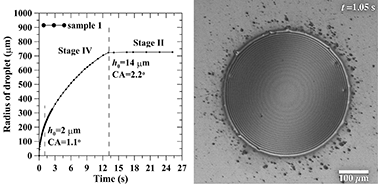当前位置:
X-MOL 学术
›
Soft Matter
›
论文详情
Our official English website, www.x-mol.net, welcomes your feedback! (Note: you will need to create a separate account there.)
Evaporation dynamics of a sessile droplet on glass surfaces with fluoropolymer coatings: focusing on the final stage of thin droplet evaporation
Soft Matter ( IF 3.4 ) Pub Date : 2018-02-14 00:00:00 , DOI: 10.1039/c7sm02192e Elizaveta Ya. Gatapova 1, 2, 2, 3, 4 , Anna M. Shonina 1, 2, 2, 3, 4 , Alexey I. Safonov 1, 2, 3 , Veronica S. Sulyaeva 1, 2, 2, 3, 5 , Oleg A. Kabov 1, 2, 2, 3, 4
Soft Matter ( IF 3.4 ) Pub Date : 2018-02-14 00:00:00 , DOI: 10.1039/c7sm02192e Elizaveta Ya. Gatapova 1, 2, 2, 3, 4 , Anna M. Shonina 1, 2, 2, 3, 4 , Alexey I. Safonov 1, 2, 3 , Veronica S. Sulyaeva 1, 2, 2, 3, 5 , Oleg A. Kabov 1, 2, 2, 3, 4
Affiliation

|
The evaporation dynamics of a water droplet with an initial volume of 2 μl from glass surfaces with fluoropolymer coatings are investigated using the shadow technique and an optical microscope. The droplet profile for a contact angle of less than 5° is constructed using an image-analyzing interference technique, and evaporation dynamics are investigated at the final stage. We coated the glass slides with a thin film of a fluoropolymer by the hot-wire chemical vapor deposition method at different deposition modes depending on the deposition pressure and the temperature of the activating wire. The resulting surfaces have different structures affecting the wetting properties. Droplet evaporation from a constant contact radius mode in the early stage of evaporation was found followed by the mode where both contact angle and contact radius simultaneously vary in time (final stage) regardless of wettability of the coated surfaces. We found that depinning occurs at small contact angles of 2.2–4.7° for all samples, which are smaller than the measured receding contact angles. This is explained by imbibition of the liquid into the developed surface of the “soft” coating that leads to formation of thin droplets completely wetting the surface. The final stage, which is little discussed in the literature, is also recorded. We have singled out a substage where the contact line velocity is abruptly increasing for all coated and uncoated surfaces. The critical droplet height corresponding to the transition to this substage is about 2 μm with R/h = 107. The duration of this substage is the same for all coated and uncoated surfaces. Droplets observed at this substage for all the tested surfaces are axisymmetric. The specific evaporation rate clearly demonstrates an abrupt increase at the final substage of the droplet evaporation. The classical R2 law is justified for the complete wetting situation where the droplet is disappearing in an axisymmetric manner.
中文翻译:

含氟聚合物涂层的玻璃表面无固定液滴的蒸发动力学:着重于薄液滴蒸发的最后阶段
使用阴影技术和光学显微镜研究了具有氟聚合物涂层的玻璃表面初始体积为2μl的水滴的蒸发动力学。使用图像分析干涉技术构建接触角小于5°的液滴轮廓,并在最后阶段研究蒸发动力学。通过热丝化学气相沉积法,根据沉积压力和激活线的温度,在热镀层上用含氟聚合物薄膜在载玻片上涂覆不同的沉积模式。所得表面具有影响润湿性能的不同结构。发现在蒸发的早期,液滴从恒定的接触半径模式蒸发,然后是接触角和接触半径随时间同时变化的模式(最终阶段),而与涂覆表面的润湿性无关。我们发现,所有样品的脱钉都发生在2.2–4.7°的小接触角上,该接触角小于测得的后退接触角。这可以通过将液体吸收到“软”涂层的显影表面中来解释,这导致形成完全润湿表面的细小液滴。最后阶段,在文献中很少讨论,也被记录下来。我们选择了一个子阶段,其中所有涂层和未涂层表面的接触线速度都急剧增加。R / h =107。对于所有涂层表面和未涂层表面,该子阶段的持续时间均相同。在该子阶段观察到的所有测试表面的液滴都是轴对称的。比蒸发速率清楚地表明在液滴蒸发的最后子阶段突然增加。对于液滴以轴对称方式消失的完全润湿情况,经典的R 2定律是合理的。
更新日期:2018-02-14
中文翻译:

含氟聚合物涂层的玻璃表面无固定液滴的蒸发动力学:着重于薄液滴蒸发的最后阶段
使用阴影技术和光学显微镜研究了具有氟聚合物涂层的玻璃表面初始体积为2μl的水滴的蒸发动力学。使用图像分析干涉技术构建接触角小于5°的液滴轮廓,并在最后阶段研究蒸发动力学。通过热丝化学气相沉积法,根据沉积压力和激活线的温度,在热镀层上用含氟聚合物薄膜在载玻片上涂覆不同的沉积模式。所得表面具有影响润湿性能的不同结构。发现在蒸发的早期,液滴从恒定的接触半径模式蒸发,然后是接触角和接触半径随时间同时变化的模式(最终阶段),而与涂覆表面的润湿性无关。我们发现,所有样品的脱钉都发生在2.2–4.7°的小接触角上,该接触角小于测得的后退接触角。这可以通过将液体吸收到“软”涂层的显影表面中来解释,这导致形成完全润湿表面的细小液滴。最后阶段,在文献中很少讨论,也被记录下来。我们选择了一个子阶段,其中所有涂层和未涂层表面的接触线速度都急剧增加。R / h =107。对于所有涂层表面和未涂层表面,该子阶段的持续时间均相同。在该子阶段观察到的所有测试表面的液滴都是轴对称的。比蒸发速率清楚地表明在液滴蒸发的最后子阶段突然增加。对于液滴以轴对称方式消失的完全润湿情况,经典的R 2定律是合理的。



























 京公网安备 11010802027423号
京公网安备 11010802027423号